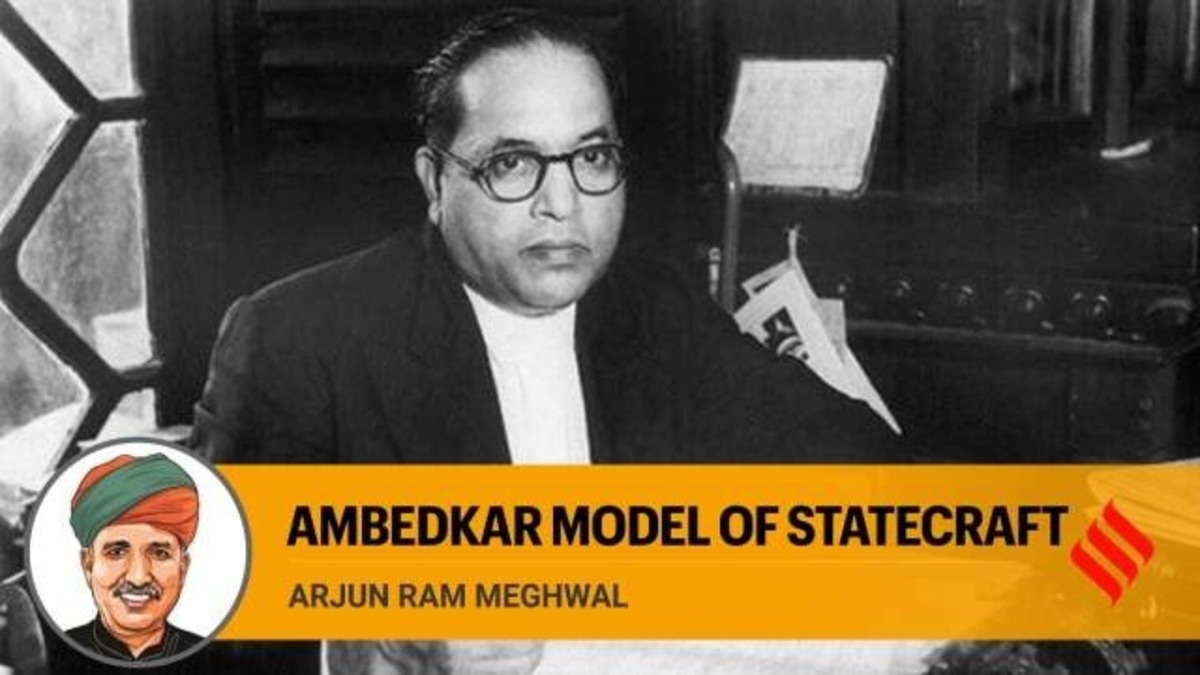Arjun Ram Meghwal writes: The dynamism to accept Ambedkar “as he is” on the one hand, and emulating his values through actions on the other, is a fitting tribute to this great son of India. India would have benefited if earlier governments had accepted Ambedkar in this manner — their commitment to public welfare would have been greater as a result. (Express Archive)
Arjun Ram Meghwal writes: Accepting and emulating his values through policy and action is a fitting tribute to this great son of India
Written by Arjun Ram Meghwal
B R Ambedkar was more than an individual — he epitomised the spirit of justice. His ideas and actions continue to illuminate the present and are a guiding light for the future. His 132nd birth anniversary is a moment to recognise the moral force behind the immortal spirit.
This anniversary marks a special occasion as it is also the centenary of Ambedkar’s work, The Problem of Rupee: Its Origin and its Solution, which paved the foundation of the Reserve Bank of India in 1934. During that time, the country was trying to come out of the clutches of colonialism and Ambedkar was vigorously advocating to usher in significant nation-building measures in a multidimensional manner. In every assignment, from his association with the Simon Commission, representing the cause of the Depressed Classes in all three Round Table conferences, as labour member in the Viceroy’s Council (1942-46) and as chairman of the Constitution’s drafting committee, he firmly safeguarded the interests of the people. He stressed establishing institutions for a just society.
The more we accept the persona of an individual, the greater the probability of emulating their ideals in practice. In the newly-independent India, a greater acceptance of Ambedkar could have led us further on the path of welfare and justice he propagated. Looking through this prism, it is apt to ask: Have we truly accepted Ambedkar?
Looking back, it is evident that for governments of Congress and others, such an acceptance did not come easily. This is illustrated by the fact that it took a struggle of 34 years to finally award Ambedkar the Bharat Ratna posthumously and to install a life-size portrait of him in the Central Hall of Parliament. It was ironic that Ambedkar’s first seated Central Hall portrait (August 9, 1989) was removed and later reinstalled on April 12, 1990, whereas the portraits of Motilal Nehru, Jawaharlal Nehru and Indira Gandhi were put in place in a comparatively shorter time. Similarly, the belongings and associated objects of the members of the Nehru family were preserved, protected and showcased at designated memorials. The concern about safeguarding the belongings of Babasaheb was absent in earlier regimes.
It is the sensitive approach of the Modi government that has taken into account and prioritised Ambedkar’s legacy. Under the Ministry of Culture’s auspices, the National Research for Conservation of Cultural Property, Lucknow, has preserved Babasaheb’s belongings for posterity. A total of 1,358 objects, including the typewriter used to draft the Constitution, have been preserved and will be showcased at the upcoming Dr B R Ambedkar Socio-Economic & Culture Centre, Chicholi Nagpur. This centre will emerge as a sacred place, highlighting glimpses of his contribution to building the nation. Spread over 11.5 acres, this centre comprises a museum and memorial, meditation hall, and library.
From 2014 onwards, actions of the Modi government indicate the acceptance of Ambedkar in totality. From the planning to the implementation level, the governance system has been conditioned to adhere to Ambedkar’s vision. It is the government’s commitment that has resulted in the dedicated development of the Panch Tirtha, Dr Ambedkar International Centre, and the implementation of pro-poor and people-centric policy measures to facilitate the ease of life of citizens. These are steps that bring the government closer to Ambedkar’s ideas. Stand-Up India, Start-Up India, PM Awas Scheme, BHIM, Mudra, and JAM trinity, among many other schemes, show that the government is leaving no stone unturned to fulfil the assigned targets and ensure saturation-level implementation.
The Prime Minister’s Panch Pran mantra for making a developed India by taking pride in our roots, removing traces of the colonial mindset, with unity and a sense of duty is also reflected in Ambedkar’s ideas. He believed that the constitutional ideals and social philosophy of “liberty, equality and fraternity” have Indian cultural roots, from the teachings of the Buddha and are not merely a legacy of the French Revolution. Azadi Ka Amrit Mahotsav, an initiative to unearth the courageous stories of unsung heroes who sacrificed their lives for the nation, is a movement to present a more complete historical perspective to future generations.
The dynamism to accept Ambedkar “as he is” on the one hand, and emulating his values through actions on the other, is a fitting tribute to this great son of India. India would have benefited if earlier governments had accepted Ambedkar in this manner — their commitment to public welfare would have been greater as a result. On his 132nd birth anniversary, let’s resolve to accept his beliefs and values to build a prosperous, just and harmonious society.
The writer is Union Minister of State for Culture & Parliamentary Affairs, and Lok Sabha MP from Bikaner
© The Indian Express (P) Ltd
